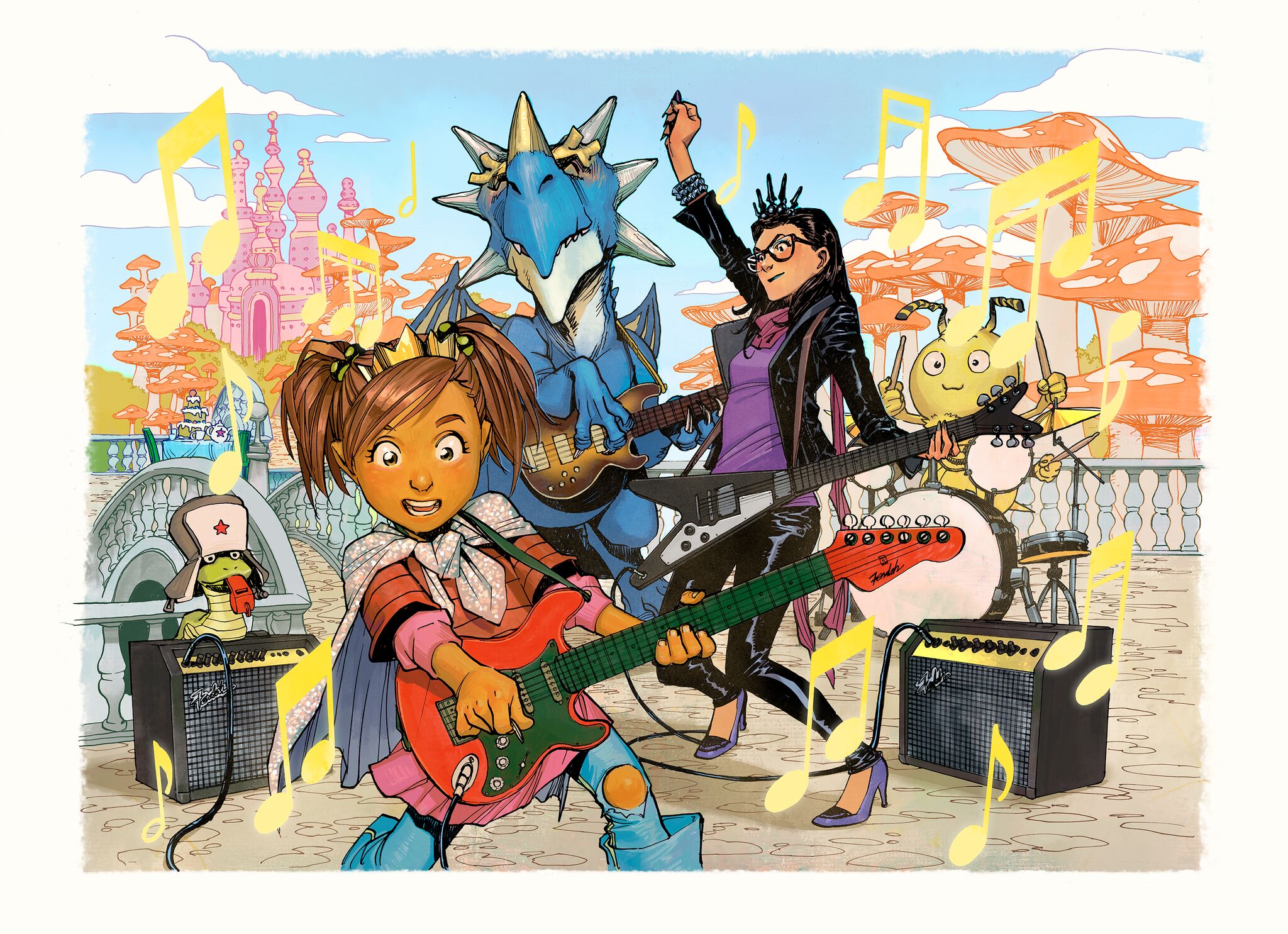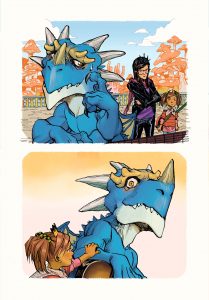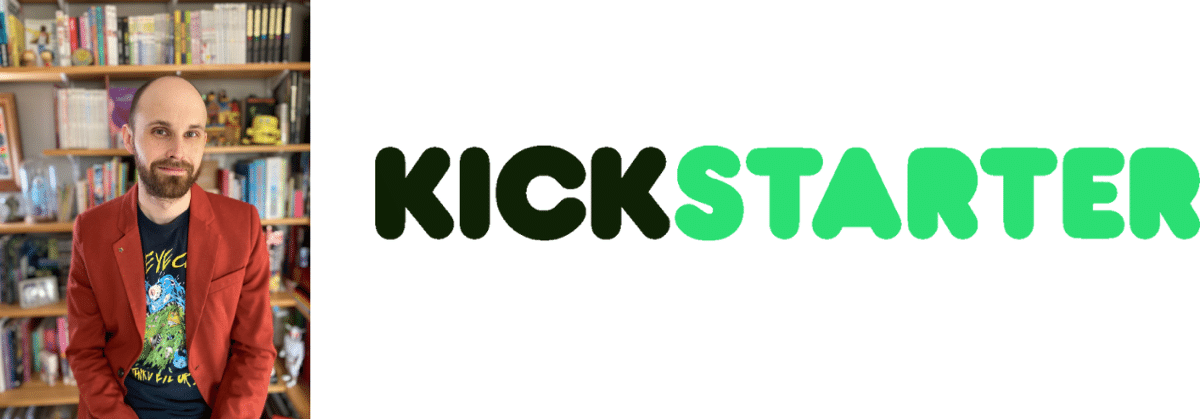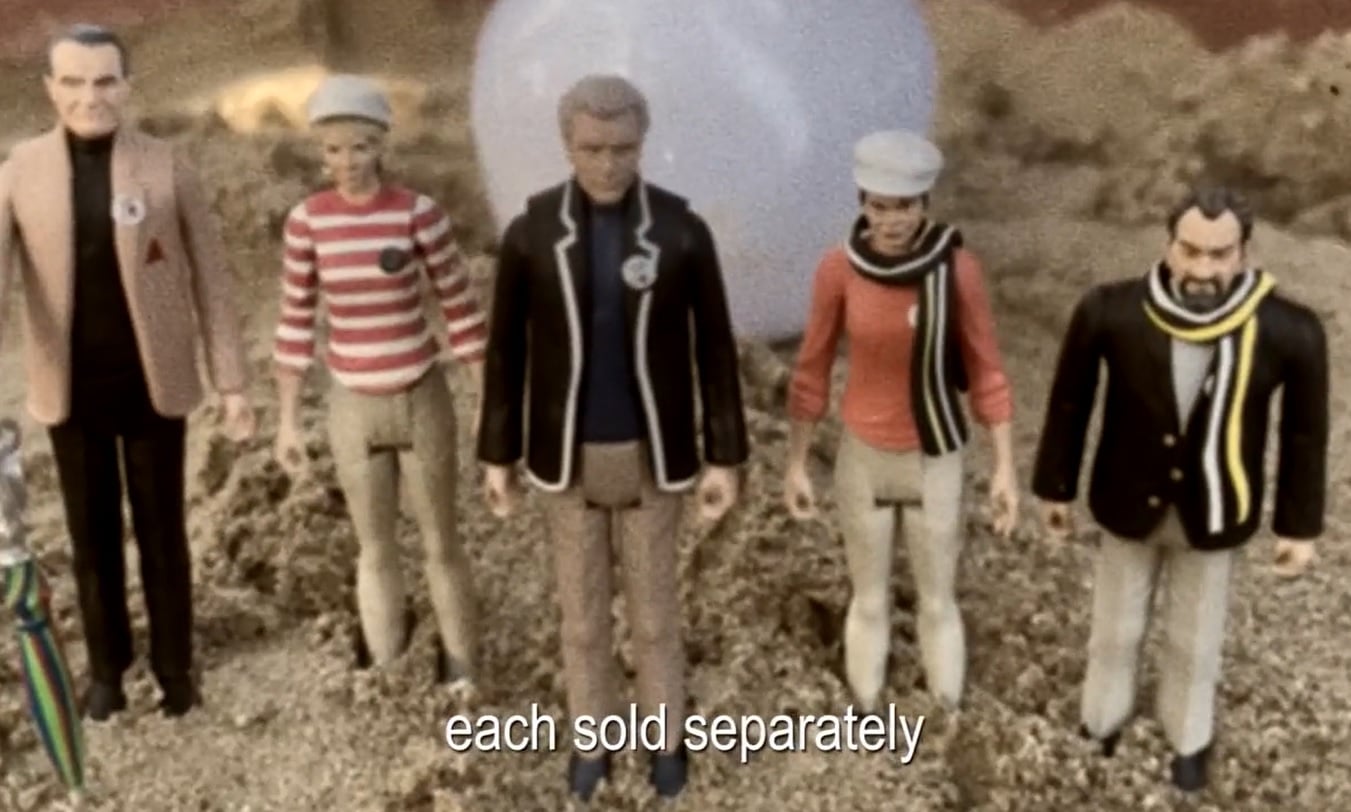It all started with a pithy observation from writer Greg Pak-
@gregpak DO IT.
— Jonathan Coulton (@jonathancoulton) November 21, 2012
And thus was born the germ of the idea would lead to two incredible Kickstarter campaign collaborations, Code Monkey Save World, a graphic novel based on the work of cult songwriter Jonathan Coulton and The Princess Who Saved Herself, a children’s book based on another Coulton song. With both projects surpassing their initial goals within 24 hours, I think it’s fair to say Pak and Coulton did not to expect the success of this magnitude with their first outings on the crowding platform.
Though they’ve changed quite a bit since they first met as classmates at Yale, Pak and Coulton still maintain a close friendship even after all these years. Between Pak’s work writing some major properties for comics such as the upcoming Firefly comics for BOOM! Studios, and Coulton’s career as the self-proclamed “internet superstar musician” who recently earned a Tony nomination for his contributions to the SpongeBob SquarePants musical, it’s understandable that their schedules haven’t permitted them for another collaboration in quite some time, until now.
Pak and Coulton have reunited along with artist Takeshi Miyazawa, colorist Jessica Kholinne, and letterer Simon Bowland for another Kickstarter campaign.
The Princess Who Saved Her Friends,which just launched today, is a sequel to the previously mentioned children’s book, that was originally a digital book as part of a stretch goal for CMSW before the creative team embarked on a separate campaign for produce a physical edition. Along with Takeshi Miyazawa, colorist Jessica Kholinne, and letterer Simon Bowland, the same creative team is back for the next tale in the life of Princess Gloria Cheng Epstein Takahara de la Garza Champion who faces her greatest challenge yet- a BATTLE OF THE BANDS! Sure it’s one thing to face your girlfriend’s seven evil exes, but try battling against a witch who’s your former enemy and current bestie, and her band The Royals!
Pak and Coulton took the time to chat with The Beat on this latest venture, reaching children and adults, and much more.
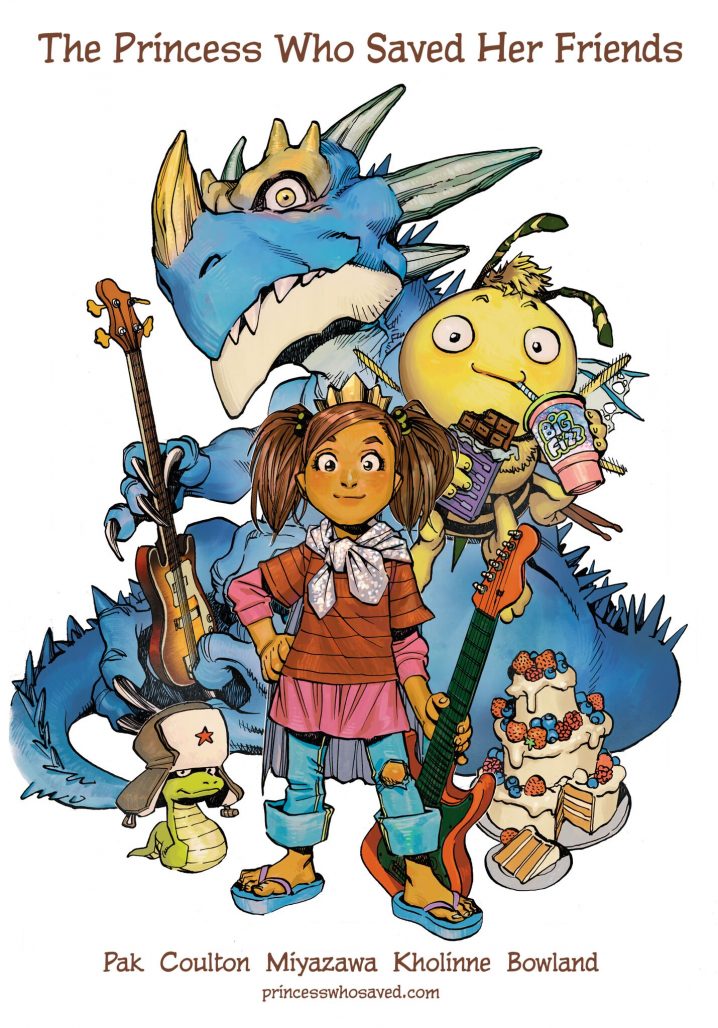
Greg Pak: We actually talked about doing some kind of follow up as soon as we finished the first book. But we didn’t rush it. With every project I’ve done with Jonathan, we’ve kind of waited until the right idea hit and made perfect sense, and then we plunge in. In this case, after several years of carrying this book around to comic book conventions and selling it to hundreds of people and seeing the reaction of all kinds of awesome parents and kids, the book’s kind of always been in the back of my head. And one day it occurred to me that the sequel should just take that next logical step in the story in the most honest way possible. At the end of the first book, Glory made friends with the mean queen. But folks don’t really change over night. So what would happen the next day, or the next week, when the queen shows her mean streak again? How does a kid deal with a mean friend? That felt like a really juicy, fun, and emotionally honest kind of story that could make for a really great kids’ book.
Dar: How does the writing process for a children’s book differ than your usual comics writing?
Pak: It’s pretty much the same except that I’m trying to use fewer panels and most of the text is narration rather than dialogue. Our amazing art team, including artist Takeshi Miyazawa, colorist Jessica Kholinne, and letter Simon Bowland, all come from comics, so we’re using the same kind of work flow to make this book.
Dar: Jonathan, obviously you’re known for your music but before these Kickstarter projects with Greg had you ever written for another medium like comics or children’s books?
Jonathan Coulton: No, I haven’t written anything other than blog posts and tweets. Greg and I talked about some of the story details in a couple of conversations, but the main idea and the spine of the story was mostly his. He wrote a draft, and then I took out the red pen that all pedantic lyricists keep in their desks, and made some adjustments for rhyme and meter. I wanted the text to flow like a song. But as much as I think of myself as a storyteller in songs, it’s clarifying watching actual writers work their craft – Greg on the projects we’ve done together, and Matt Fraction on the graphic novel for my album Solid State. Writing a whole book is a very different beast, and it’s a pleasure to watch an expert make it go.
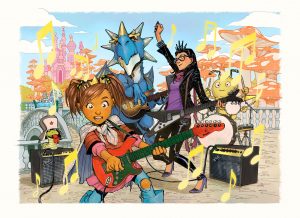
Coulton: My daughter was that age where she was just fearless and loud and climbing all over everything. It’s really thrilling to watch your kids go through that phase where they haven’t yet learned how to be afraid of the world. I was thinking a lot about what kinds of stories got put in front of her, what kinds of toys she was being told to like, and I decided to write about a little girl who loved princess stuff but was also totally kickass. That’s who she was, and I felt like there weren’t too many stories about kids like that.
Dar: What were your favorite children’s picture books growing up and they have influence on this project?
Pak: We just let Tak[eshi] do his thing — I love his style and knew he’d nail it. But colorist Jessica Kholinne and I did brainstorm a lot about coloring choices and styles. I sent her a bunch of images from kids’ books I love, including a bunch of William Steig’s books, and we took inspiration from that vibrant but still subtle watercolor look you often see there.
Coulton: I deferred to Greg and Tak on the visual stuff, because I’m kind of a dummy in that area. But I will tell you that my favorite kids book of all time was The Story of Ferdinand. I really identified with that bull, because he didn’t want to run around acting all angry, he just wanted to sit under a tree and smell flowers. That was the kind of kid I felt like inside.
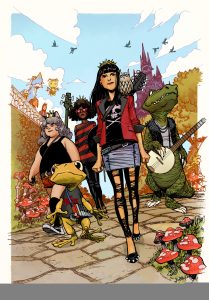
Pak: At some point in figuring out the plot, I realized we needed to raise the stakes by having the queen ditch Glory and her friends for new friends. I can’t remember whether I came up with the idea of the Royals or if that was you, Jonathan — do you remember?
Coulton: I remember I was eating eggs at a diner with you, but I’m not sure who’s brainstorm that was. We were kind of tossing stuff back and forth, and that’s the one that really stuck with both of us. The other band, that’s a lot better than your band, and also they dress really cool and they’re a little older and tougher. I’m still terrified of those people, and I’m a 47-year-old professional musician.
Dar: Takeshi Miyazawa is an artist whom you’ve obviously developed a close relationship with since co-creating Amadeus Cho and your most recent Mech Cadet Yu book for BOOM. How has both the working and personal relationship developed between you and Takeshi in the last decade or so?
Pak: I love Tak. I’ve said it before, and it’s totally true — somehow he lives inside my head and just completely gets the characters and character beats I write. When I write for Tak, I just know he’s going to nail all the nuances I’m going for — all the pathos and humor and tragedy and joy that are conveyed in both tiny and big ways. He’s just a tremendous actor as an artist, which is soooo key in comics and children’s books. He brings so much life to everyone he draws. I basically never want to stop writing for Tak.
Dar: As someone who studied and works in marketing, I’ve noticed in the last few years, with children’s entertainment particularly, that products once intended specifically for boys, like superheroes, are much more inclusive to the female demographic and vice versa. Did you have a particular audience in mind with this book?
Pak: I write books for everyone. So of course we figured the book would find a natural audience with girls and parents of girls, and that’s incredibly gratifying. But I’ve been thrilled at comic book conventions by how many dads have bought the book for their sons. That’s actually kind of a thing — dads getting a kick out the book and giving it to their little boys. I just love that. I think everybody should be comfortable identifying with characters of all different backgrounds. And in this day and age, I think it’s particularly important for boys to have the chance to read books with girl heroes.
Coulton: I’ve definitely noticed a change in my own kids, at least compared to how I grew up. Neither has any problem at all identifying with characters who are not like them, and they don’t seem to make big distinctions between “boy stuff” and “girl stuff.” I’ve certainly come to appreciate how important representation is in the stories we tell, and I’m very cheered by the fact that the arrow of time seems to be moving us in the direction where any voice can tell a story that we care about. And of course, there are so many universals among us humans, that it’s pretty easy to come up with stories and characters that do speak to everyone.
Dar: Greg, for this interview, I dived back into the case study for a Fordham graduate school class you were kind enough to let me conduct about your Kickstarter campaigns. Obviously. social media is an essential component for any creator promoting projects in this modern age. To put it delicately, the landscape of social media has changed tremendously in the years since your last Kickstarter and you have been vocal about your criticisms regarding certain aspects of social media. Will you still be using social media as a tool to promote The Princess Who Saved Her Friends, if so which platforms?
Pak: Oh, you bet I’m using social media to promote this! Pushing this kind of project is a huge part of why I’m on social media in the first place. I owe my career to the internet and email newsletters and social media — those tools helped me promote my independent film Robot Stories a decade and a half ago and have helped me build my career and reach awesome readers and audience members ever since. So yes, I’m very critical of many social media companies and their failure to clamp down on trolls and harassment. But the tools themselves remain critical for independent media makers trying to reach their audiences, and the vast majority of readers who follow my social media accounts are positive and wonderful. I deleted Facebook a few months ago, but I’ll be using Twitter and my other social media accounts to tout the Kickstarter. I’ve also built up my email newsletter since the last time I ran a Kickstarter, so I’m hopeful that will have an impact as well.
Coulton: Absolutely. Things have changed a lot in the social media landscape, and I think generally it’s just much harder to get attention than it once was. But it’s hard to beat a free broadcast channel that reaches tens of thousands of your fans. And like Greg, I wouldn’t be where I am without social media. We’re going through some pretty difficult growing pains as we all figure out what it means when everyone has the same megaphone, and as much as I would like to just scrap it all and go sit under a tree and smell the flowers, I’d rather stay in it and try to make it better. And I think part of that is using it to spread positive ideas, share the stuff we create, and continue connecting with the people we care about.
Dar: The original Princess Kickstarter campaign had a 15 day goal but it looks like the sequel will be 30 days which is a major time commitment. Does the longer campaign mean it has a larger scope? Will it be longer than the original Princess book which was around 30 or so pages?
Pak: No, the new book is the same length and format of the original. The longer campaign is just to give us our best chance of hitting our goal. The first Princess book started out as a stretch goal for the Code Monkey Save World Kickstarter, so we’d already paid our artists out of the CMSW kitty and had a finished digital book that we just needed to print. So that target was lower and we figured we didn’t need a long campaign. But with this sequel, we’re starting from scratch and need to pay our art team out of the Kickstarter proceeds, so we have a higher goal and want to make sure we have time to hit it.
Dar: I don’t want to jinx it, but I wouldn’t be surprised if this new Princess book follows pattern of your previous Kickstarters and gets fully funded in less than a day. Have you already discussed potential stretch goals?
Pak: We actually just mentioned that possibility to each other today! We haven’t really been thinking about it — we never really know what’s going to happen when we launch one of these, and have no idea how hard it’ll be to hit our goal. So we’re taking it step by step. If we’re lucky enough to have to think about stretch goals, we’ll cross that bridge when we come to it.
Coulton: I told Greg that I have completely given up on making predictions about anything. I mean, who knows! We set our goal pretty low because we really just want to clear the bar enough to make the thing. If we end up doing better than that, fantastic. But we’ll see!


